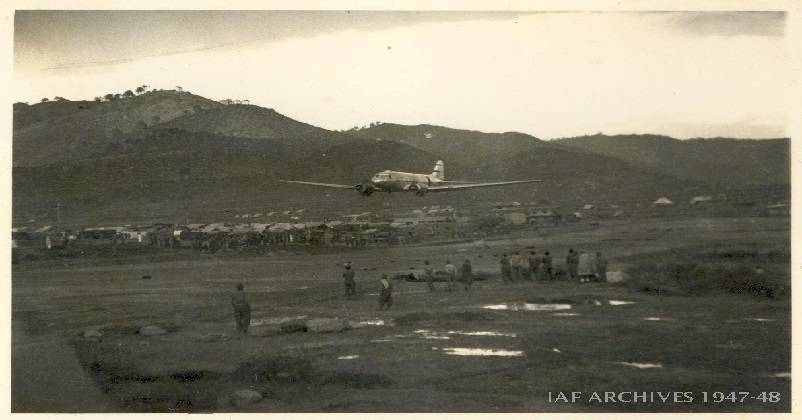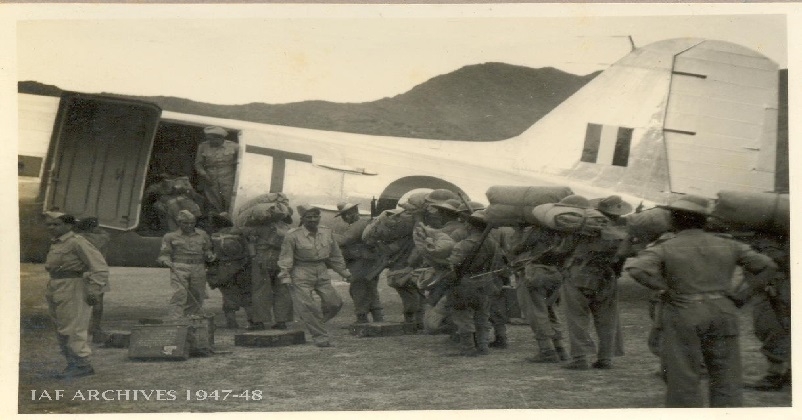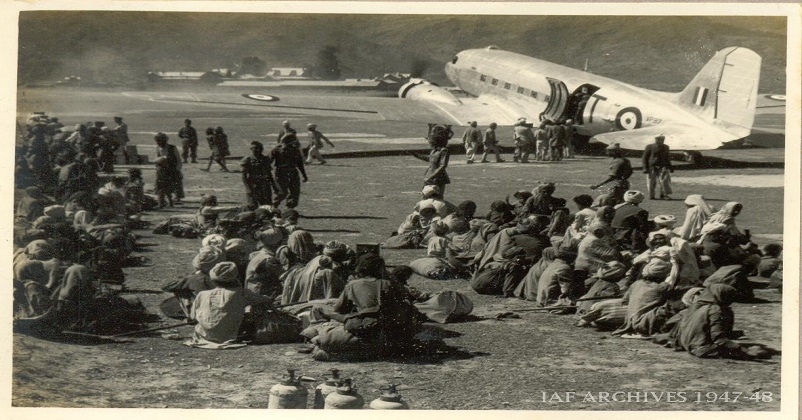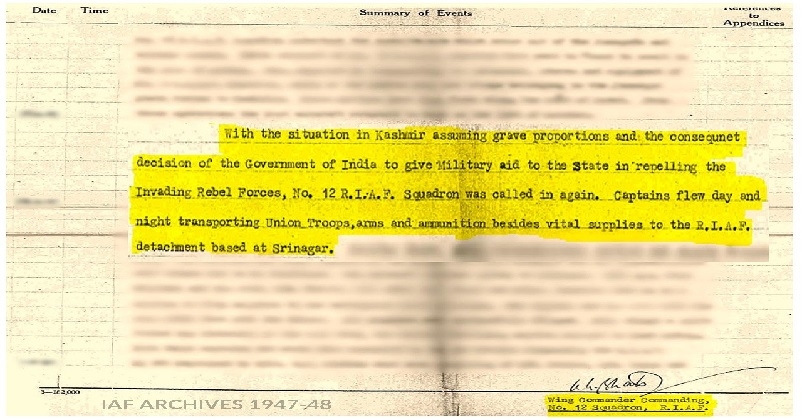History #Revision Part03 : India's rescue operation after Pakistan's invasion on Jammu Kashmir in 1947
12-Nov-2022

Though J&K became part of India on 26 October 1947 in law but when the Indian forces landed in Kashmir on 27 October, the situation there was critical in the extreme. Soon after the martyrdom of Lieutenant Colonel Rai in Kashmir by the Pakistani invaders, the Army Headquarters in India took in hand preparations for a large scale campaign. By then, it had become clear that the threat to J&K was grave and powerful, and that the Indian army must throw it’s full weight into the fighting before the invaders would be driven out.
INDIA TO THE RESCUE
Delhi and East Punjab Command was ordered on 8 October to carry out Phase II of Operation 'Jak', according to the first phase of which 1 Sikh had been landed at Srinagar the previous day. Phase II involved the immediate despatch of one Brigade Group to Jammu via the Pathankot road. At the same time, Delhi and East Punjab Command was also ordered to send one Brigade Headquarters (Headquarters 161 Indian Infantry Brigade), a signal section, one infantry battalion, and one platoon of medium machine guns to Srinagar. These reinforcements were to be despatched by air on 29 October and 30 October, so that the Srinagar contingent might be brought up to the strength of one brigade as soon as possible.
Moreover, urgent messages were flashed across that day to all the military Commands in India, asking them to report immediately what troops they could make available for the Kashmir operations. The next day, 29 October, the Eastern Command and Southern Command reported on the troops they could immediately spare and troops' trains soon began rolling up towards Delhi and Pathankot. Simultaneously, East Punjab Area was told to move two troops of armoured cars and one battalion out of the 50 Para Brigade to Srinagar as early as possible.

Urgent messages continued to arrive from Brigadier Atal and others at Srinagar about the critical situation in the Valley and the need for immediate reinforcements and air sorties, on 30 October two fighter aircraft of the Royal Indian Air Force were detailed to operate from the Srinagar airstrip itself, in order to afford air support to the hard-pressed ground troops. Although the Srinagar airstrip was totally lacking in all the modern facilities for combat aviation, in the succeeding days a number of Harvards and Spitfires were based on that airfield and gave invaluable support to the infantry.
In the Valley, the situation remained critical on 28 October. One Viceroy's Commissioned Officer and five men had been killed and fifteen men wounded that morning when Colonel Rai died. The troops, 1 Sikh less two companies, therefore, withdrew some distance, together with the remnants of the State forces, now totalling only about 60 men. The city of Srinagar, although unaware of the exact gravity of the situation, was tense. The enemy was freely using artillery and mortars now, but for some unaccountable reason refrained from pressing home any major attack.
The fly-in of more troops continued, but one Dakota with 21 men had to force-land near Jammu due to engine trouble. Another Dakota dropping supplies into Kotli was fired upon by the enemy from the surrounding hilltops. It was slightly damaged, but flew on to Delhi after completing its mission. Fighter planes of the Royal Indian Air Force carried out strafing sorties around the Baramula-Uri area at 1100 hours on 28 October, and destroved a number of motor lorries.
The position in the evening of 29 October was distinctly better, though far from satisfactory. Brigadier J.C. Katoch had arrived to take command of 161 Brigade, and Lieut Colonel Sampuran Bachan Singh took over the command of 1 Sikh, which had now Indian elements of 1/1 Punjab and 3/15 Punjab, plus 13 Battery Royal Indian Artillery under it, which gave it a strength of nearly 950 men. So far, 1 officer, 1 Viceroy's Commissioned Officer and 11 Other Ranks had been killed, and 1 Viceroy's Commissioned Officer and a score of Other Ranks wounded since the start of the Kashmir operations.

The supply and equipment problem was still unsolved. There was an acute shortage of petrol, and 161 Brigade had to use commandeered civil buses with defective batteries. The destruction of Maura power-house had stopped the flour mills in Srinagar from working, so no flour was available from the civil sources for the troops.
The tactical situation was also less dangerous, at least for the hour. By the reports available, it appeared that only about 500 of the invaders were trying to push directly along the Baramulla-Srinagar road, although they were the best-equipped troops among the raiders and were adequately supplied with mortars, machine guns and mechanical transport. On the other hand about 1,500 raiders were reported to be taking the route via Sopore and Bandipur, reaching Srinagar from the north.
This threat for the moment could be ignored, for the march round the Wular Lake was long and the road indifferent. Another 200 raiders were trying to outflank the Pattan position from the south by advancing down the Tangmarg road which met the Baramula Srinagar road at Narabal. Narabal was a place of great importance, therefore, and was that day defended by 1 ((Para) Kumaon. The front position was east of Pattan near milestone 16, and was held by 1 Sikh, 13 Battery Royal Indian Artillery and Indian elements of three platoons of 3/15 Punjab with 6 medium machine guns.
On 30 October, reports indicated greater numbers of the enemy in the Pattan area. There were about 200 lorries, and the men were estimated to total 1500-2000. During the night of 29/30 October, the enemy indulged in only some sniping of forward Indian positions, which however proved largely ineffective. But at 1900 hours on 30 October, one of the Indian convoys was ambushed at the bridge and suffered several casualties. The leading lorry of the three-lorry convoy had in it only a civilian driver, who was wounded. The second was carrying another civilian driver and five Kumaonis. Out of this, three Kumaonis were killed and one Kumaoni and the driver were wounded.
The third lorry also was fired at, but sustained no casualties. A fighting patrol of 1 (Para) Kumaon was immediately despatched to the area, but at 1930 hours it found that the enemy had already disappeared. Half-an-hour later, at 2000 hours the main position near Pattan was attacked by some 1000 raiders, who approached to within 55 metres of the defensive positions, but were then held up and thrown back. Their attack was supported by light machine guns and 3-inch mortars, but the deadly stream of bullets from the Indian medium machine guns proved too much for them.
On 31 October, no major engagement took place in the Valley. Reports described two parties of 300-350 raiders advancing from Pattan towards Sumbal and Magam apparently to outflank the defenders' positions near Pattan from both sides. But the only incident worth mention took place in the morning when Brigadier Katoch was slightly wounded in the leg by a stray bullet as he got down from his jeep to inspect the 1 Sikh positions. On 1 November 1947, 184 men of 1 Sikh and 81,038 kg of supplies were transported by air to Srinagar. Colonel Harbakhsh Singh reached Srinagar that day and took over the command of 161 Brigade.
The fighting during the day was fitful, but bitter. At 0830 hours, a patrol of 1 Sikh was ambushed. The Sikhs were surprised, but quickly fell in, and the fight lasted about four hours. At the end, they came through with advantage, having lost five men killed and one wounded, but after killing 12 raiders, wounding five and capturing one. Between 1300 and 1500 hours on 1 November, a fairly heavy attack was launched by the raiders against the 1 Sikh position, but was repulsed without difficulty. Patrols of 1 (Para) Kumaon went towards Gandarbal and Sumbal, but could discover no enemy in the area.
In Jammu area, the Advance Headquarters 50 Para Brigade, one company of 1 Mahar and one company of 3 (Para) Rajput were at Jammu, one company of 3 (Para) Rajput was at Samba and a third company was at Madhopur. The 3 (Para) Rajput less three companies was moving up to Jammu from Gurdaspur. Brig L.P. Sen arrived at Srinagar on 2 November and took over the command of 161 Brigade from Col Harbakhsh Singh, who became his Deputy Brigade Commander.
On 3 November a bitter battle took place near the Srinagar airfield itself. That morning one company of 1 (Para) Kumaon and two companies of 4 Kumaon went to reconnoitre the Badgam area. The company of 1 (Para) Kumaon took up positions on a ridge near Badgam while one company of 4 Kumaon returned towards Srinagar at 1230 hours. The other company of 4 Kumaon was suddenly attacked by about 700 raiders at 1400 hours at a point just north of Badgam. Taken by surprise and greatly outnumbered the company fought bravely but suffered heavy casualties. The raiders were apparently trying to sneak in and capture the Srinagar airfield itself. When their presence was discovered they naturally tried their best to overwhelm the single company of 4 Kumaon with repeated and desperate attacks.

On receiving information 161 Brigade immediately sent one company of 1 (Para) Kumaon with spare ammunition to help the defenders. Seven air strikes were also launched at the same time to hold up the raiders' attacks. These air attacks had a very salutary effect and succeeded in killing a large number of the raiders, but the company of 1 (Para) Kumaon sent as reinforcement did not succeed in throwing the enemy back.
At the end of the battle the Indian casualties were 15 killed, including Major Somnath Sharma, and 26 men wounded. One of the ammunition trucks was also looted by the enemy, but the enemy attacks were at last held, their surreptitious advance on the airfield was stopped and they suffered several hundred casualties by bombing and strafing from the air and in the hand-to-hand fight. Major Somnath Sharma was posthumously awarded the Param Vir Chakra for his gallant action.
Before his death, Major Somnath Sharma had sent the following memorable message to his Brigade Headquarters-"The enemy are only 50 yards from us. We are heavily outnumbered. We are under devastating fire. I shall not withdraw an inch but will fight to the last man and the last round." The next day, 4 November 1947, Sardar Patel, the Deputy Prime Minister, and Sardar Baldev Singh, the Defence Minister, flew down to Srinagar to observe things on the spot and to study the situation. They returned the same evening to Delhi and apparently impressed on the Cabinet the need for further urgent reinforcements in Srinagar.
The Budgam battle and many recce reports showed that the raiders were fanning out from the Baramulla road and spreading themselves all over the Valley in small groups. This would present a very difficult task to the 161 Inf Bde. Brig L.P. Sen decided that the only way to make them concentrate again and to present a good target was to offer them the great prize of Srinagar as a bait, with the possibility of bringing up their lorries by the Baramula road to carry away the loot. So on 4 November he withdrew 1 Sikh from their strong positions near Pattan to a point only about 8 km from Srinagar on the Baramula road, much against the opposition of the Battalion Commander and the annoyance of Maj-Gen Kalwant Singh.
At 0130 hours during the night of 5/6 November the invaders launched an attack against the position of 1 Sikh at a bridge. This attack was held but heavy fighting continued. At 0630 hours on 6 November a troop of 7 Cavalry (armoured cars) was sent up to reinforce the 1 Sikh and air strikes were launched against the attackers. Later during the day 1 (Para) Kumaon Battalion was also sent forward and the raiders' attacks were beaten back.
On 6 November Army Headquarters (India) ordered Delhi and East Punjab Command that the Kashmir Valley was to be held at all costs and close liaison was to be maintained between the Indian Commander and Sheikh Abdullah, who had been appointed the Administrator of Kashmir. Any incident of communal nature was to be severely repressed and all help was to be given to the Kashmir Home Guards including rifles and facilities for training.
By the evening of 6 November the critical days for Srinagar were over. The raiders had lost the initiative because of their looting propensities displayed at Baramulla. About 3500 men of the Indian Army had by then reached Srinagar and had thrown a ring of machine guns and bayonets around Srinagar and the airfield. Although the raiders were only about 8 km away from the city at the nearest point, it was now impossible for them to pierce through the positions of the defenders and capture the glittering prize almost within their grasp.
On the other hand the Indian troops had recoiled adroitly before the full force of the enemy blow could reach them and had by now consolidated the position. Reinforcements including field guns and armoured cars had reached them in sufficient numbers. The liberation of the Valley was about to begin.
To be continued………